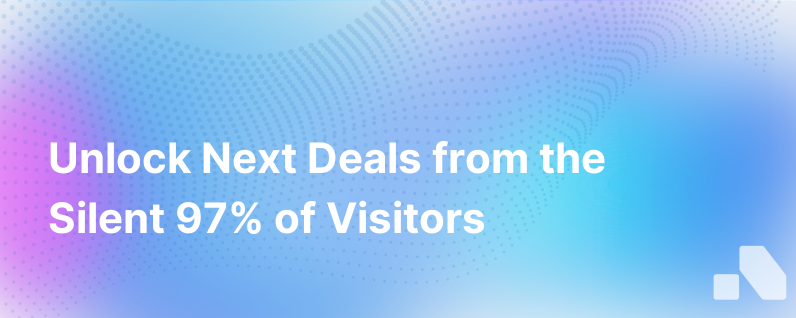Only 3 Of Web Visitors Fill Out On Site Forms Heres How The Other 97 Can Reveal Where Your Next Deals Are
Published on October 3, 2023 by Sawyer Middeleer
As a B2B company, capturing leads is crucial for driving growth and generating revenue. That's why web forms are an essential component of your website, allowing visitors to provide their contact information and express interest in your product or service. However, research shows that only 3% of web visitors actually fill out on-site forms. So what happens to the other 97%? In this article, we will explore strategies to uncover the potential of the 97% and turn them into valuable leads, helping you identify where your next deals are.
Why do visitors not fill out on-site forms?
There are several reasons why visitors may choose not to fill out on-site forms:
-
Friction: Lengthy, complex, or intrusive forms can be off-putting and discourage visitors from taking the time to complete them.
-
Lack of time: Visitors may be in a hurry or simply not have the time to fill out a form.
-
Lack of trust: Visitors may be hesitant to provide their personal information due to concerns about privacy or a lack of trust in the company.
-
Lack of motivation: Visitors may not see a clear value proposition or benefit in filling out the form.
These factors can significantly impact your lead generation efforts. However, with the right strategies, you can still capture valuable information and turn those missed opportunities into potential deals.
Leveraging intent data to identify potential leads
One way to uncover the potential of the 97% is by leveraging intent data. Intent data refers to the behavioral data collected from various sources, such as website visits, content downloads, and social media interactions. This data provides insights into a visitor's interests, buying intent, and pain points, even if they don't fill out a form.
By analyzing intent data, you can gain a deeper understanding of your website visitors and their needs. This allows you to identify potential leads who are actively researching and showing interest in your industry or product. Intent data can reveal valuable information, such as the pages or content they engage with, the time spent on your website, and the keywords they use in search engines. Armed with this information, you can tailor your outreach and engage with these potential leads more effectively.
Using IP tracking and reverse IP lookup
Another strategy to uncover the potential of the 97% is by using IP tracking and reverse IP lookup technologies. IP tracking allows you to identify the companies that visit your website, even if individual visitors don't fill out a form. With the help of reverse IP lookup tools, you can match the IP addresses to specific company names and gather relevant company information.
This information provides valuable insights into the types of companies that have shown interest in your website and allows you to prioritize outreach efforts. You can then tailor your messaging and outreach based on the industry, company size, or other firmographic data. This data-driven approach can significantly increase the effectiveness of your lead generation efforts and help you focus on high-potential accounts.
Implementing chatbots for real-time engagement
Chatbots have become increasingly popular in recent years, and for a good reason. They offer a proactive and interactive way to engage with website visitors in real-time, even if they don't fill out a form. Chatbots can initiate conversations, answer questions, and guide visitors through their journey, providing a personalized experience.
By implementing chatbots on your website, you can capture information from visitors who may not have otherwise engaged. Chatbots can ask qualifying questions, understand the visitor's needs, and collect contact details or other relevant information to pass on to your sales team. This allows you to have more meaningful conversations with potential leads and move them further along the sales funnel.
Conclusion
While only 3% of web visitors fill out on-site forms, there is untapped potential within the remaining 97%. By leveraging intent data, IP tracking, reverse IP lookup, and chatbot technologies, you can reveal where your next deals are coming from. These strategies help you capture valuable information about your website visitors and identify potential leads, even if they don't fill out a form. By implementing these tactics and focusing on engaging with those who have shown interest, you can significantly improve your lead generation efforts, increase conversions, and drive business growth.